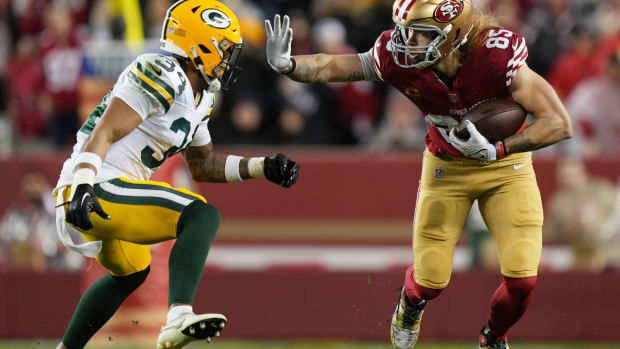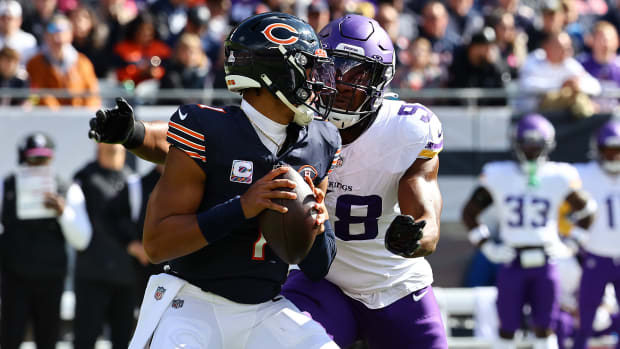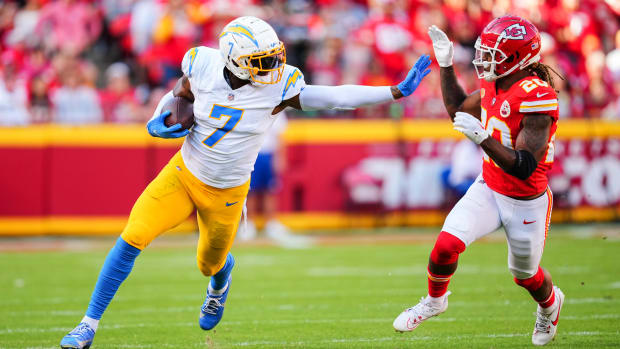Meeting Needs in This Mock Draft Means Trades
A great deal occurred for the Bears since the last BearDigest mock draft, version 3.0.
The last mock draft occurred in what is normally the first week of the combine. Now it's spring, free agency is a week old counting the legalized tampering period, and time for another attempt at setting the board.
The needs have changed somewhat since the last mock. The most pressing Bears need remains a long-term quarterback, but not enough has changed in terms of how the top quarterbacks in the draft are viewed.
It still looks like a top-heavy first round at quarterback, with all of the top five likely to be gone by at least No. 12.
For the Bears to move up from 20 to 11, 10 or earlier would require too many picks they need to fill holes. Some of these are holes created by their problems retaining talent due to the salary cap while others are because they had free agents who left.
The last draft was the first seven-rounder and with BearDigest Mock Draft 4.0 the trade is introduced, via Pro Football Focus' draft simulator.
As the first round ticked forward, quarterback Trey Lance somehow made it within five picks and an attempt was made twice to move up and take him but to no avail. The deals were rejected and Lance fell all the way to the Washington Redskins, one pick before the Bears selected.
Along the way, tackle Christian Darrisaw also went, so the Bears were left possibly drafting tackle Tevin Jenkins or a receiver.
Talk about frustrating when someone like Lance was that close but no one would make a reasonable trade. The simulator didn’t allow trading picks from future years, which is really what they would have done in this situation.
However, Lance did not own a monopoly on the falling quarterback market. Alabama quarterback Mac Jones had also been falling. Pro Football Focus had him graded as No. 33 on the board, a top second-round pick.
Knowing the New Orleans Saints might draft Jones at No. 28, I traded down once Lance was taken, accepted the Baltimore Ravens pick at No. 27 a spot ahead of New Orleans and they also coughed up a fourth-rounder (131) and sixth-rounder (210). By dropping down in Round 1, I still came away with quarterback Mac Jones.
Round 1: QB Mac Jones, Alabama
The Bears have their quarterback of the future chosen at No. 27 and even though it wasn't Lance, PFF liked the ingenuity and awarded an A+ for the trade and also for the selection. They’re getting a quarterback without much running ability but great smarts and quick with the decisions.
As it was, PFF didn't really like much else done in this draft but didn't hate it, either, and awarded a B+ overall draft grade.
Round 2: T Jalen Mayfield, Michigan
At No 52, all the top tackles were gone but Mayfield was ranked No. 70. The Bears need to start thinking about tackles and Mayfield is a massive 6-5, 320-pound right tackle type who was ranked down at No. 70 but all the top tackles were gone and the Bears need one. While this might be classified as a reach, Mayfield is familiar with Bears offensive line coach Juan Castillo from
2019 when Castillo was an O-line advisor to the Wolverines. He'd be a good understudy to Germain Ifedi for this season and Ifedi has only a one-year contract.
Round 3: WR Cade Johnson, South Dakota State
PFF had him grade No. 83 and he was by far the highest graded receiver available at this pick, but still only earned a C+ grade here. Johnson is a slippery slot receiver type with good speed and change of direction and would make a good fit to replace Anthony Miller if the Bears actually do trade their second-round pick from 2018, as reports have suggested.
Round 4: CB Kary Vincent, LSU
With the 131st pick acquired in the Round 1 trade down from Baltimore, cornerback is a necessity and Vincent has been described by scouts as an all-purpose type who could be used in the slot or on the outside. Not especially big at 5-10, 189, he did make six career interceptions. The Bears might try him in the slot and see if his quickness is up to the challenge after they cut Buster Skrine. He could challenge Desmond Trufant for the left cornerback spot Kyle Fuller had until he was cut for cap purposes and went to Denver. Truth be told, my plan was for a cornerback in Round 3 and receiver in Round 4 or 5 but Johnson was rated far and away the best receiver at the time he was taken and no cornerback available commanded such a high rating.
More Trades
Two trades were made to lose picks but gain quality. PFF didn't much like these, doling out C grades for each deal. However, they're using their board for these grades and the Bears here are using what I think Ryan Pace would do. Pace has drafted only three players in six years in Rounds 6 or 7 who started a game. Javon Wims, Arlington Hambright and Duke Shelley were those players. Hambright and Shelley did it only due to emergency situations with injuries and COVID-19, while Wims also started a few times due to injuries or aligning with extra receivers. Since Pace isn't going to select anyone in Rounds 6 or 7 of real value, I dealt those to move up into rounds where he has been comfortable finding talent. He's been effective in Round 5, having found Jordan Howard, Darnell Mooney, Adrian Amos and Bilal Nichols then. So I dealt picks 204, 221 and 228 from Round 6 to the Las Vegas Raiders for the 167th pick in Round 5 Then traded the 210th pick acquired in Round 6 in the trade down to take Mac, as well as the 208th pick in Round 6 to the Dallas Cowboys for the 179th pick in Round 5.
Round 5: T Brady Christensen, BYU
Chose at No. 167, the Bears can use two tackles and Christensen is lighter on his feet but not quite the mauler Mayfield is, so he would be a left tackle candidate if the Bears want to unload Charles Leno Jr. in the future. Christensen is said to have no glaring weakness beyond needing to learn to handle top-level NFL pass rushers who can cut low and hard around the edge with numerous moves. In other words, he's like any rookie tackle.
Round 5: TE Tony Poljan, Virginia
At No. 179 was Tony Poljan, the 6-foot-7, 265-pound tight end who started his career as a quarterback at Central Michigan but then switched to tight end and made 83 career receptions, all but 12 in his final two years at Central Michigan and Virginia. His catch total increased when he stepped up in competition with Virginia and who knows what kind of Philly Special the Bears can come up with using a tight end passing who can actually pass? The Bears likely won't have Jimmy Graham after 2021, if then. They'll need another tight end with size like this in the red zone.
Twitter: BearDigest@BearsOnMaven




